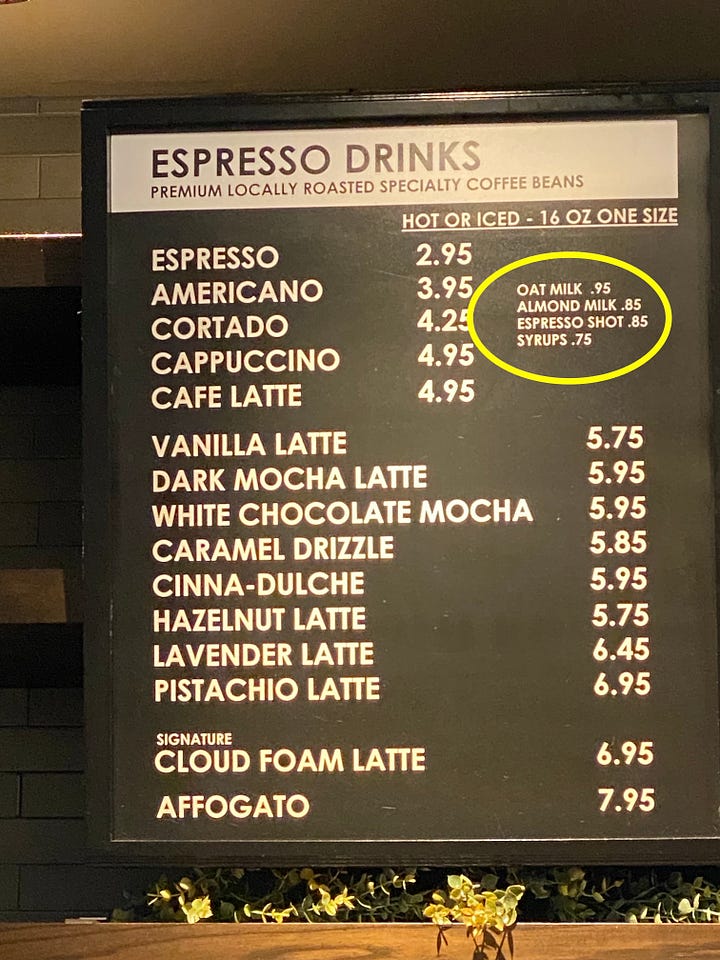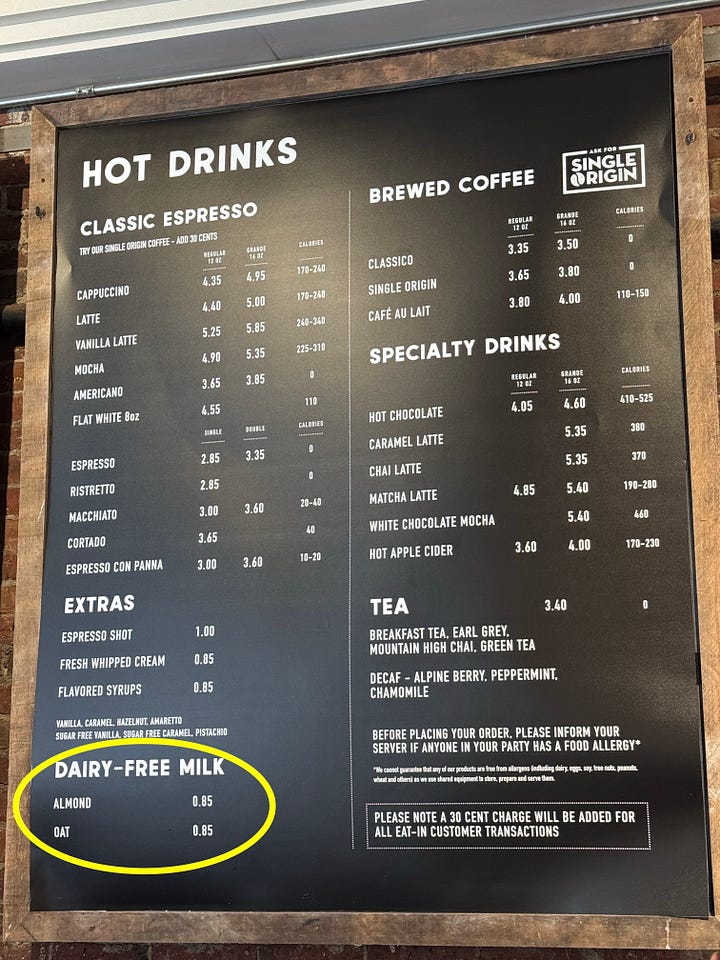I found one! I actually found one!
When I spotted the unicorn, I nearly dropped to my knees. For years I’d been searching, and I’d come across it practically by accident when I went to meet a friend for coffee.
Funny how discoveries you dream about can suddenly materialize when you least expect them.


To be clear, I would have preferred almond milk in my latte. The coffee bar only offered oat milk. But who am I to get too picky when there is no extra fee tacked on!1
My long-suffering exposure to the “non-dairy tax” regularly imposed by coffee shops has amused my husband when I’ve prattled on in protest about it. He thought I was just being dramatic.
But then said husband texted me when he was out on a walk the other day. He was heading to a coffee place, and could he pick up something for me? I responded with a latte order. The look on his face when he showed up in my home office, latte in hand, spoke volumes. “A dollar!” he yelped. “They charged me a dollar extra! For almond milk! That’s an expensive habit!”
Ah, darling. I did everything I could to shape my expression into a face of knowing agreement. I might have winked. I said little else besides thanking him for the caffeinated treat, for actual words may have landed me in a fight I didn’t want to have when I had a latte to enjoy.
Now you get it, I telecommunicated. Welcome to the world I, and every lactose-intolerant and/or vegan person in the universe, live in. You have felt the sting for yourself. And you didn’t even have to live through the adverse effects of consuming dairy to do it.
I am grateful for my microwave, my handheld foamer, my cinnamon shaker, my actual pumpkin spice powder (not artificially-flavored, sweetened syrup), my real vanilla extract, my coffee drawer full of beans and espresso, my bean grinder, my French Press, my pour over filter cone, my compact Nespresso machine with its waste-creating little pods. (Thank goodness those things can be recycled!) I don’t go out daily to buy my fancy coffees at the coffee shop. I make them at home.
Coffee shops charge between $.70 and $1.00 per cup for adding plant-based milks to barista drinks. Some tack on the surcharge if you request non-dairy milk for simple brewed coffee, too, unless they put out carafes at add-your-own milk and sugar stations, though many of these have not been reinstated since Covid took them out of service.
The additional cost may seem trivial if you go out for coffee once a week. Who honestly does that? If you have a coffee problem like I do, you may drink three or more coffees a day.
For all of you who hated graphs and word problems in school math, I’ll try to make this easier to digest than a glass full of cow milk.
Someone drinking three coffees a day throughout a standard five day workweek would save well over $700 over the course of a year, and over $1,000 if they buy coffee drinks every day. That savings comes from the “milk” alone! Forget about the base cost of the coffee drink itself.
Isn’t there something you could do with that money?
The upcharge originated long before we started calling soy milk, almond milk, coconut milk and the like “plant-based milks.” That’s new 21st century vocabulary. For a long time, the sole non-cow option was soy. The consumers who wanted it were a niche minority. With low demand, establishments did not need to stock a lot, so they received no volume purchasing benefit. It was not always available through regular distributors, either, adding labor to the equation. The cost for a coffee bar to procure soy milk and minimize product waste was clearly higher than their overhead for (subsidized) cow milk. Offering it in their stores was a specialty courtesy, the cost for which was passed off to consumers.
The niche aspect and demand has changed. Food trends evolved, and an array of choices came with them. After soy came almond milk. U.S. consumers eventually embraced oat milk as Europeans had been doing for some time, perhaps aided by the endearingly quirky humor of Swedish brand Oatly’s ad campaigns. As the “coconut is a healthy fat” craze saturated consumer’s consciousness, coconut milk earned its place on some non-dairy milk menus. Occasionally, macadamia and other nut milks make appearances, even rice milk.
As coffee businesses proliferated, they copied the surcharge model, and it became standard practice. Everyone did it, so practically everyone still does. Little has adjusted to reflect the escalation of non-dairy milk demand as greater segments of the population opt for plant-based products. You’d think by now that there would be some economies of scale.2
I kicked off an ad hoc one-person awareness raising campaign years ago, starting with the big guys. I hoped to use my influence as a rewards card-carrying member of the Starbucks community (wink, wink) to get the company to address this egregiously discriminatory practice.
There are people who are vegan or vegetarian as a lifestyle choice; those who, by religious doctrine or ethical considerations avoid consuming products that come from a cow. Then there is the rest of us. People like my son, whose body produces zero lactase, the enzyme needed to break down the proteins in milk. People like me, whose are not just lactose-intolerant but allergic to everything made with cow’s milk. Ingesting milk, butter, cream, etc. can induce a range of reactions, from rashes to laryngitis, congestion, asthma, and a slew of gastrointestinal effects.
I canvassed Starbucks baristas and store managers. They pawned responsibility off on Corporate. I looked up how to contact Corporate. Since I wasn’t reaching out with press or investment or marketing opportunities, my options whittled down to Customer Service. Perfect!
Except that Customer Service wasn’t a helpful representative, but an email address. I shot off an email and received this in return:
I think that remote order got lost in the shuffle because that response never came.
Not easily discouraged, I tried again.
This time, Customer Service turned out to be a bot.
You know you’ve really touched a policy nerve when the bots ghost you without a little chat first.
I moved on to independent shops and smaller chains. One guy I chatted with managed a gourmet foods and sandwich shop that had a great location right on the corner of a busy main street, across from a public transit station and a Trader Joe’s (where these days you can buy a half gallon of refrigerated Non-Dairy Oat Beverage for $3.99 or a similar carton of Non-Dairy Almond Beverage for $2.99).
I asked him to waive the surcharge for the almond milk in my latte.
“No, we charge for almond milk,” he said.
“Why?” I wanted to know.
“We always have.”
“Right. But don’t you have a lot of customers who order it? Do you have any idea what kind of volume you churn, especially compared to regular milk?”
He admitted that he didn’t, off the top of his head.
I asked him if he knew which customers tended to order their drinks with the soy, almond, or oat options. “A lot of vegetarians,” he surmised.
“You mean vegans?”
“I get those confused. I always thought they were the same?”
“No. So, mostly it’s a matter of lifestyle choice?”
“I mean, no. It costs more.”
“I imagine some of the cheeses you put on sandwiches cost more relative to each other, too, but you don’t charge more for imported Havarti than cheddar.” I countered that going for the non-dairy milk is a choice for some, a biological necessity for others. That the extra cost felt a bit like punishment on top of injury.
I might have gone on a rant: It’s not my fault I can’t eat ice cream! I’d love to douse my drinks with half-and-half! Perhaps we should petition to have the non-dairy milk upcharge covered under the Americans with Disabilities Act (ADA)? If you’ve experienced the throes of a lactose intolerant reaction, you know they can be downright debilitating! Picture your friend, a co-worker or your mother crouched over, or writhing on the floor in fetal position, trying to dispel a tornado of pain blazing through their gut. Don’t let your imagination veer towards the explosive destruction that the storm can churn out. It’s not a pretty sight!
I might not have. Because he listened generously, admitting that he had never thought about the fact that opting for non-dairy milk wasn’t simply a dietary choice based on trendy preference, but need. He committed to looking more closely at his numbers.
He was the only one to hear me out thoughtfully, and offer a modicum of hope that he would make a change.
The shop went out of business before that could happen. My quest for the surcharge-free coffee soldiered on…until I stumbled upon the unicorn.
Update!
Starbucks has been struggling in recent years. The company has a mess of issues to unknot, so they brought in a new CEO this year, a man named Brian Niccol.
On the recent earnings call with investors, Mr. Niccol announced that Starbucks will be dropping the extra charge for plant-based milks.
Huzzah!
The unicorns will be coming out in force. Let the stampede begin!
In case you’re wondering, this unicorn was the George Howell coffee bar in Clover Food Labs in Massachusetts.
The picture is complicated, of course, by base cost of production and the degree to which agricultural sectors are subsidized. Rather than getting too weedy on those details here, the point is that the cost of all milks ordered by customers could be averaged out into the menu pricing structure, eliminating the surcharge for a particular group of customers.










